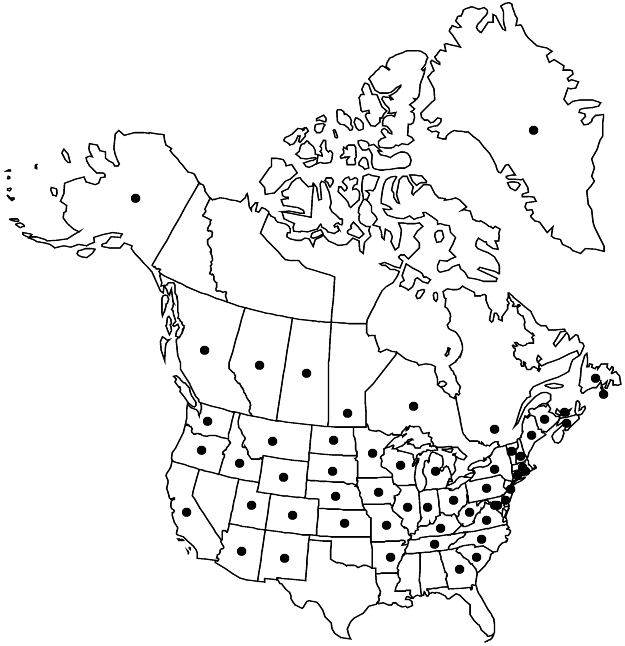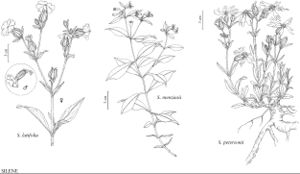Difference between revisions of "Silene latifolia"
Voy. Barbarie 2: 165. 1789.
FNA>Volume Importer |
imported>Volume Importer |
||
| Line 8: | Line 8: | ||
}} | }} | ||
|common_names=White campion or cockle;silène blanc | |common_names=White campion or cockle;silène blanc | ||
| + | |special_status={{Treatment/ID/Special_status | ||
| + | |code=I | ||
| + | |label=Introduced | ||
| + | }}{{Treatment/ID/Special_status | ||
| + | |code=F | ||
| + | |label=Illustrated | ||
| + | }} | ||
|basionyms={{Treatment/ID/Basionym | |basionyms={{Treatment/ID/Basionym | ||
|name=Silene alba | |name=Silene alba | ||
| Line 58: | Line 65: | ||
|elevation=0-2800 m | |elevation=0-2800 m | ||
|distribution=Greenland;St. Pierre and Miquelon;Alta.;B.C.;Man.;N.B.;Nfld. and Labr. (Nfld.);N.S.;Ont.;P.E.I.;Que.;Sask.;Alaska;Ariz.;Ark.;Calif.;Colo.;Conn.;Del.;D.C.;Ga.;Idaho;Ill.;Ind.;Iowa;Kans.;Ky.;Maine;Md.;Mass.;Mich.;Minn.;Mo.;Mont.;Nebr.;N.H.;N.J.;N.Mex.;N.Y.;N.C.;N.Dak.;Ohio;Oreg.;Pa.;R.I.;S.C.;S.Dak.;Tenn.;Utah;Vt.;Va.;Wash.;W.Va.;Wis.;Wyo.;Eurasia. | |distribution=Greenland;St. Pierre and Miquelon;Alta.;B.C.;Man.;N.B.;Nfld. and Labr. (Nfld.);N.S.;Ont.;P.E.I.;Que.;Sask.;Alaska;Ariz.;Ark.;Calif.;Colo.;Conn.;Del.;D.C.;Ga.;Idaho;Ill.;Ind.;Iowa;Kans.;Ky.;Maine;Md.;Mass.;Mich.;Minn.;Mo.;Mont.;Nebr.;N.H.;N.J.;N.Mex.;N.Y.;N.C.;N.Dak.;Ohio;Oreg.;Pa.;R.I.;S.C.;S.Dak.;Tenn.;Utah;Vt.;Va.;Wash.;W.Va.;Wis.;Wyo.;Eurasia. | ||
| + | |introduced=true | ||
|discussion=<p>European botanists recognize several subspecies of <i>Silene latifolia</i>, at least two of which appear to occur in North America: <i></i>subsp.<i> latifolia</i> [<i>S. alba</i> subsp. divaricata (Reichenbach) Walters], a commonly occurring form here, with acuminate calyx teeth and patent to recurved capsule teeth; and <i></i>subsp.<i> alba</i> (Miller) Greuter & Burdet, less common in North America, with short, obtuse calyx teeth and erect teeth in the dehisced capsule. However, most of our material tends to be intermediate, making recognition of subspecies here of little value. Presumably there has been extensive gene exchange between populations of this outbreeding species since its introduction into North America.</p><!-- | |discussion=<p>European botanists recognize several subspecies of <i>Silene latifolia</i>, at least two of which appear to occur in North America: <i></i>subsp.<i> latifolia</i> [<i>S. alba</i> subsp. divaricata (Reichenbach) Walters], a commonly occurring form here, with acuminate calyx teeth and patent to recurved capsule teeth; and <i></i>subsp.<i> alba</i> (Miller) Greuter & Burdet, less common in North America, with short, obtuse calyx teeth and erect teeth in the dehisced capsule. However, most of our material tends to be intermediate, making recognition of subspecies here of little value. Presumably there has been extensive gene exchange between populations of this outbreeding species since its introduction into North America.</p><!-- | ||
--><p>The name <i>Silene latifolia</i> has been misapplied to <i>S. vulgaris</i> by some authors, which has been a cause of confusion.</p> | --><p>The name <i>Silene latifolia</i> has been misapplied to <i>S. vulgaris</i> by some authors, which has been a cause of confusion.</p> | ||
| Line 82: | Line 90: | ||
|publication title=Voy. Barbarie | |publication title=Voy. Barbarie | ||
|publication year=1789 | |publication year=1789 | ||
| − | |special status= | + | |special status=Introduced;Illustrated |
| − | |source xml=https:// | + | |source xml=https://bitbucket.org/aafc-mbb/fna-data-curation/src/2e0870ddd59836b60bcf96646a41e87ea5a5943a/coarse_grained_fna_xml/V5/V5_389.xml |
|subfamily=Caryophyllaceae subfam. Caryophylloideae | |subfamily=Caryophyllaceae subfam. Caryophylloideae | ||
|genus=Silene | |genus=Silene | ||
Latest revision as of 22:10, 5 November 2020
Plants annual or short-lived perennial; taproot woody. Stems erect or decumbent at base, branched, to 100 cm, finely hirsute, glandular-puberulent distally. Leaves: blade hirsute on both surfaces; basal usually withering by flowering time, petiolate, blade oblong-lanceolate to elliptic; cauline sessile, reduced into inflorescence, blade lanceolate to elliptic, 3–12 cm × 6–30 mm, apex acute. Inflorescences several–many-flowered (fewer in pistillate plants), open, dichasial cymes, bracteate; bracts much reduced, lanceolate, herbaceous. Pedicels 1–5 cm. Flowers unisexual, some plants having only staminate flowers, others having only pistillate flowers, fragrant, 25–35 mm diam.; in veined staminate plants subsessile to short-pedicellate, in pistillate plants pedicellate; calyx prominently 10-veined in staminate flowers, 20-veined in pistillate, tubular, becoming ovate in pistillate flowers, 10–20(–24) × 8–15 mm in fruit, margins dentate, hirsute and shortly glandular-pubescent, lobes to 6 mm, broadly ovate with apex obtuse, to lanceolate with apex acuminate; petals white, broadly obovate, ca. 2 times calyx, limb spreading, unlobed to 2-lobed; stamens equaling to slightly longer than calyx; stigmas (4–)5, slightly longer than calyx. Capsules ovate, ca. equaling calyx, opening by (4–)5, spreading to slightly reflexed, 2-fid teeth; carpophore 1–2 mm. Seeds dark gray-brown, reniform-rotund, plump, ca. 1.5 mm, coarsely tuberculate. 2n = 24.
Phenology: Flowering summer–fall.
Habitat: Arable land, roadsides, waste land
Elevation: 0-2800 m
Distribution

Introduced; Greenland, St. Pierre and Miquelon, Alta., B.C., Man., N.B., Nfld. and Labr. (Nfld.), N.S., Ont., P.E.I., Que., Sask., Alaska, Ariz., Ark., Calif., Colo., Conn., Del., D.C., Ga., Idaho, Ill., Ind., Iowa, Kans., Ky., Maine, Md., Mass., Mich., Minn., Mo., Mont., Nebr., N.H., N.J., N.Mex., N.Y., N.C., N.Dak., Ohio, Oreg., Pa., R.I., S.C., S.Dak., Tenn., Utah, Vt., Va., Wash., W.Va., Wis., Wyo., Eurasia.
Discussion
European botanists recognize several subspecies of Silene latifolia, at least two of which appear to occur in North America: subsp. latifolia [S. alba subsp. divaricata (Reichenbach) Walters], a commonly occurring form here, with acuminate calyx teeth and patent to recurved capsule teeth; and subsp. alba (Miller) Greuter & Burdet, less common in North America, with short, obtuse calyx teeth and erect teeth in the dehisced capsule. However, most of our material tends to be intermediate, making recognition of subspecies here of little value. Presumably there has been extensive gene exchange between populations of this outbreeding species since its introduction into North America.
The name Silene latifolia has been misapplied to S. vulgaris by some authors, which has been a cause of confusion.
Selected References
None.
